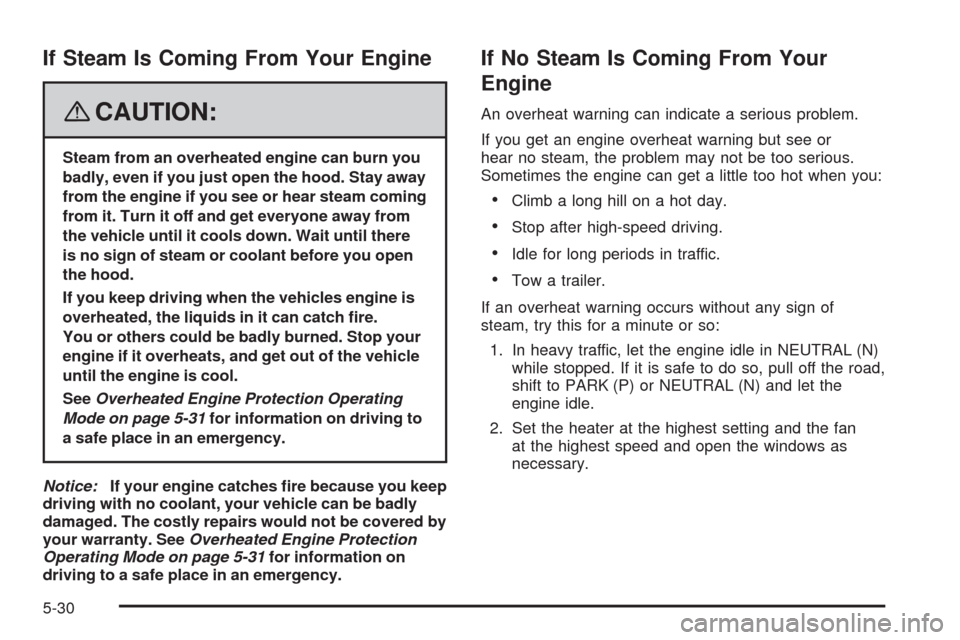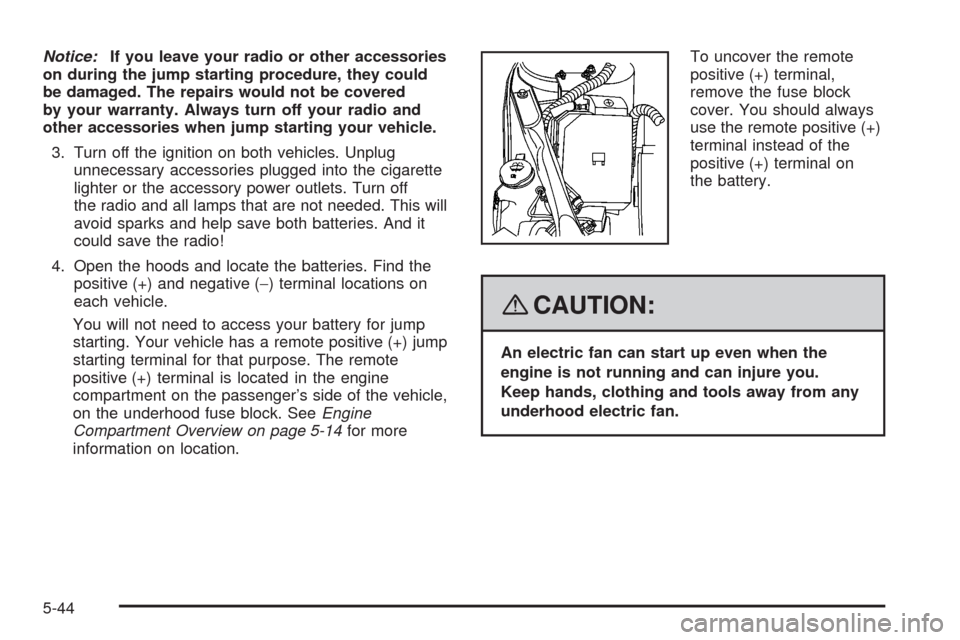Page 276 of 400

If Steam Is Coming From Your Engine
{CAUTION:
Steam from an overheated engine can burn you
badly, even if you just open the hood. Stay away
from the engine if you see or hear steam coming
from it. Turn it off and get everyone away from
the vehicle until it cools down. Wait until there
is no sign of steam or coolant before you open
the hood.
If you keep driving when the vehicles engine is
overheated, the liquids in it can catch �re.
You or others could be badly burned. Stop your
engine if it overheats, and get out of the vehicle
until the engine is cool.
SeeOverheated Engine Protection Operating
Mode on page 5-31for information on driving to
a safe place in an emergency.
Notice:If your engine catches �re because you keep
driving with no coolant, your vehicle can be badly
damaged. The costly repairs would not be covered by
your warranty. SeeOverheated Engine Protection
Operating Mode on page 5-31for information on
driving to a safe place in an emergency.
If No Steam Is Coming From Your
Engine
An overheat warning can indicate a serious problem.
If you get an engine overheat warning but see or
hear no steam, the problem may not be too serious.
Sometimes the engine can get a little too hot when you:
Climb a long hill on a hot day.
Stop after high-speed driving.
Idle for long periods in traffic.
Tow a trailer.
If an overheat warning occurs without any sign of
steam, try this for a minute or so:
1. In heavy traffic, let the engine idle in NEUTRAL (N)
while stopped. If it is safe to do so, pull off the road,
shift to PARK (P) or NEUTRAL (N) and let the
engine idle.
2. Set the heater at the highest setting and the fan
at the highest speed and open the windows as
necessary.
5-30
Page 290 of 400

Notice:If you leave your radio or other accessories
on during the jump starting procedure, they could
be damaged. The repairs would not be covered
by your warranty. Always turn off your radio and
other accessories when jump starting your vehicle.
3. Turn off the ignition on both vehicles. Unplug
unnecessary accessories plugged into the cigarette
lighter or the accessory power outlets. Turn off
the radio and all lamps that are not needed. This will
avoid sparks and help save both batteries. And it
could save the radio!
4. Open the hoods and locate the batteries. Find the
positive (+) and negative (−) terminal locations on
each vehicle.
You will not need to access your battery for jump
starting. Your vehicle has a remote positive (+) jump
starting terminal for that purpose. The remote
positive (+) terminal is located in the engine
compartment on the passenger’s side of the vehicle,
on the underhood fuse block. SeeEngine
Compartment Overview on page 5-14for more
information on location.To uncover the remote
positive (+) terminal,
remove the fuse block
cover. You should always
use the remote positive (+)
terminal instead of the
positive (+) terminal on
the battery.
{CAUTION:
An electric fan can start up even when the
engine is not running and can injure you.
Keep hands, clothing and tools away from any
underhood electric fan.
5-44
Page 294 of 400
Headlamps, Front Turn Signal,
Sidemarker, and Parking Lamps
A. Sidemarker
B. Low-Beam Headlamp
C. High-Beam Headlamp
D. Parking/Turn Signal LampTo replace one of these bulbs:
1. Open the hood. SeeHood Release on page 5-13
for more information.
2. Remove the screw from the headlamp assembly.
5-48
Page 392 of 400

G
Gage
Engine Coolant Temperature.........................3-38
Fuel..........................................................3-43
Speedometer..............................................3-29
Tachometer.................................................3-29
Garage Door Opener.......................................2-41
Gasoline
Octane........................................................ 5-6
Speci�cations............................................... 5-6
Glove Box.....................................................2-48
GM Mobility Reimbursement Program.................. 7-6
H
Hazard Warning Flashers................................... 3-6
Head Restraints............................................... 1-7
Headlamp
Aiming.......................................................5-47
Headlamp Wiring............................................5-99
Headlamps
Bulb Replacement.......................................5-47
Daytime Running Lamps/Automatic Headlamp
System...................................................3-16
Delayed.....................................................3-15
Exterior Lamps............................................3-14Headlamps (cont.)
Flash-to-Pass............................................... 3-9
Halogen Bulbs............................................5-47
Headlamps, Front Turn Signal, Sidemarker,
and Parking Lamps..................................5-48
High/Low Beam Changer................................ 3-8
Heated Seats................................................... 1-4
Heater...........................................................3-22
Highbeam On Light.........................................3-43
Highway Hypnosis...........................................4-14
Hill and Mountain Roads..................................4-15
Hood
Checking Things Under................................5-12
Release.....................................................5-13
Horn............................................................... 3-6
How to Wear Safety Belts Properly...................1-15
I
Ignition Positions.............................................2-22
Infants and Young Children, Restraints...............1-34
In�ation - Tire Pressure...................................5-61
Instrument Panel
Overview..................................................... 3-4
Instrument Panel (I/P)
Brightness..................................................3-17
Cluster.......................................................3-28
6